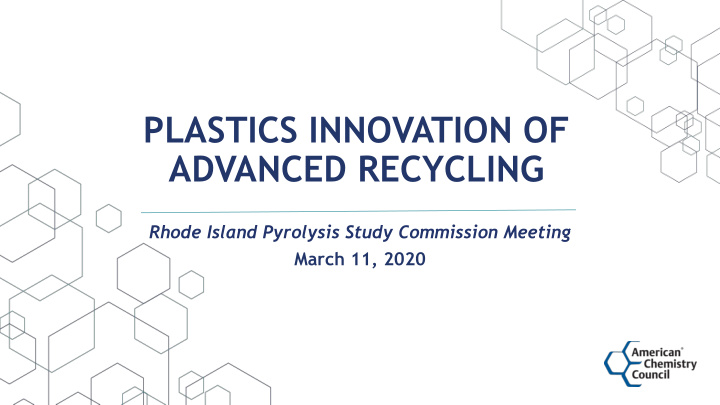



PLASTICS INNOVATION OF ADVANCED RECYCLING Rhode Island Pyrolysis Study Commission Meeting March 11, 2020
“Reduce” via Plastics Packaging Greenhouse gas 5000 4377 4500 4000 3310 3500 3000 2500 2000 1500 1051 1000 500 0 Steel Can Plastic Canister Plastic Brick Source: Franklin Associates, September, 2008
U.S. Resin Manufacturer Sustainability Goals 2040 Goal • 100% of plastics packaging is reused, recycled or recovered 2030 Interim Goal • 100% of plastics packaging is recyclable/recoverable Best Practice Goal • 100% of Division’s U.S. manufacturing sites participate in Operation Clean Sweep Blue by 2020, with all North American sites by 2022
What is Advanced Recycling? Leveraging chemistry to convert post-use plastics into valuable products which extend the life of the plastic Outputs: • Virgin like plastics • Specialty chemicals • Basic building blocks (monomers) • Chemical feedstocks (naphtha) • Fuels Products are then used as alternative to fossil based products
1) Define, Inventory, and Target 2) Invent New Circular Business Models 3) Increase Access and Infrastructure Example of Pyrolysis Process 1. Post-use plastics received 2. Prep: Shredding, drying and pelletizing 3. Pellets extruded (solid liquid) and fed into pyrolysis vessel 4. Material heated and vaporized (no combustion) 5. Vapor is captured and cooled into a hydrocarbon liquid 6. Hydrocarbon liquid ultra-low sulfur diesel, naphtha (gasoline) and wax 7. Finish products shipped to offtake customer
1) Define, Inventory, and Target 2) Invent New Circular Business Models 3) Increase Access and Infrastructure Case Example: Brightmark Energy • Location: Ashley, Indiana • $260M financing packaging • Input: 100,000 tons of post-use plastics/annually • Output: 18M gal ultra-low sulfur diesel & naphtha + 6M gal of wax • $138.3M capital investment in Steuben County, IN • Job creation: International Brotherhood Electrical Workers (IBEW), Union Boilermakers, International Brotherhood of Bridge Structural and Ornamental Workers, and Pipefitters
1) Define, Inventory, and Target 2) Invent New Circular Business Models 3) Increase Access and Infrastructure Case Example: Enerkem • Location: Edmonton, Alberta, Canada • Input: post-use plastics & recovered feedstock • Output: methanol & ethanol (10M gal/yr) • Over C$350M venture capital- backed financing • C$13.3M equity ownership from Government of Québec
1) Define, Inventory, and Target 2) Invent New Circular Business Models 3) Increase Access and Infrastructure Boosting the Economy in Rhode Island
1) Define, Inventory, and Target 2) Invent New Circular Business Models 3) Increase Access and Infrastructure Expanded Economic Opportunity *Post-use, recoverable plastics sourced from a 100 mile radius from the state
Investments in Traditional & Advanced Recycling
Infrastructure Investments, Circular Solutions Examples
Manufacturing vs. Solid Waste Management Manufacturing Facility Solid Waste Management Facility Facility Equipment Extruders, high temperature Equipment to sort, separate, reactors, distillation columns, size, and grind incoming condensers, piping materials; feed conveyors Products of facility activities Crude oil, diesel, gasoline, Baled, containerized, and fuels, chemicals, waxes, packaged materials lubricants, chemical feedstocks, diesel and gasoline blendstocks Potential environmental Air emissions, water Waste handling; odor, dust, impacts discharges, product storage, nuisance, vector, fire hazard, raw material storage etc. Regulated by Department of Yes Yes Environmental Management
Requirements Applicable to Advanced Recycling Code Description • • Air 250-RICR-120-05-9 et seq. Pre-construction permit requirements • Operating permit requirements • 250-RICR-120-05-29 et seq. • Limits on and requirements for emission of various • pollutants, recordkeeping and reporting 250-RICR-120-05-01 through 27 • • Water 250-RICR-150-10-1 et seq. Water discharge permit requirements • • 250-RICR-150-10-1.16 Effluent limitations and requirements • • 250-RICR-150-10-1.32 Stormwater discharge requirements • • Land 250-RICR-140-05-1 Prohibition against storing solid waste without required permits
Environmental Benefits Are Significant 1) Define, Inventory, and Target 2) Invent New Circular Business Models 3) Increase Access and Infrastructure
Craig Cookson Senior Director, Recycling and Recovery ACC Plastics Division craig_cookson@americanchemistry.com (202) 249-6622
Appendix
Addressing Environmental Concerns Emissions • Fewer emissions than a food processing facility, university campus or auto manufacturer Dioxins • Material is heated in a closed, oxygen-deprived environment • No atmospheric oxygen or halogens
Improved Efficiency of Gasification Increase in plastics feedstock = Performance of gasification • Up to 28% improvement in thermal efficiency • Up to 42% more methanol production • Decreased char/ash to landfill by up to 76%
Recommend
More recommend